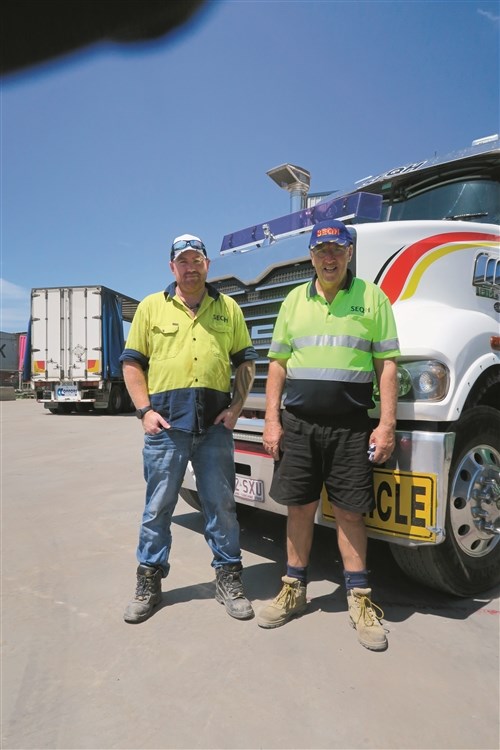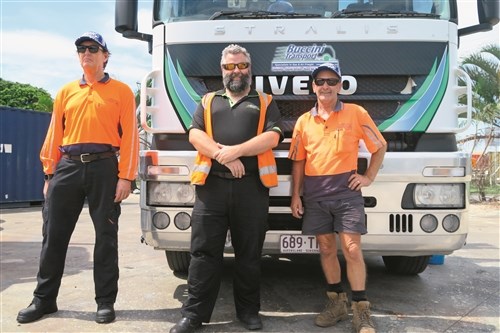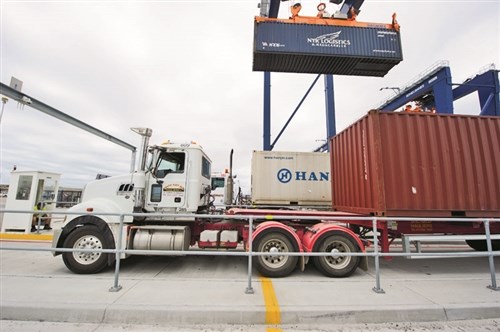A project gauging safety and well-being in port haulage promises an alternative concept to old-world compliance
Sometimes, like missing the forest for the trees, it’s too easy to get hung up with the complexity of technology and miss the simple expediency it can provide.
Add to this another saying – prevention is better than cure – and you have the rails on which a Queensland truck driver safety trial is being built.
The aspect ATN was introduced to in March is part of the two year Heavy Vehicle Safety Around Ports (HVSAP) project flagged in December focused on fatigue.
It is centred on SmartCap technology, and is a coalescing of pleasingly Australian insight, intelligence and compassion on several levels.
Born of a need to head off a nasty spike in trucking fatalities around the port in 2017 and driven by the Queensland Trucking Association (QTA) and the Port of Brisbane (POB), it seeks to make an undeniable case to policy-makers that there is a better way to approach fatigue prevention than the one formulated nearly a century ago.
In the digital tech scheme of things, Queensland-born SmartCap and its technology is venerable – some 15 years from founding to its present multinational and multi-industry position.
 |
|
Drivers Matt Miller and Kenny Payne of SEQ Hauliers
|
The simplicity mentioned belies its modernity but given it is possible to gauge the human brainwaves through electroencephalography to reveal the precursor signals of human fatigue.
It makes sense to use that to alert drivers so action can be taken to get truck drivers’ attention in order.
If drivers can be the initial receivers of such warnings and, well, who wouldn’t take heed that their safety and indeed life is at increasing risk?
More so if they have personal interaction with software on their own hardware?
For drivers, this particular part of the multi-pronged project is no more difficult than attaching a SmartCap LifeBand headband and monitoring the fatigue readings and, when levels are trending upwards dangerously, acting on the warnings.
The latter come as constant beeping, intrusive enough to demand action.
It is the sort of thing Queensland Trucking Association (QTA) CEO Gary Mahon has spent much of the last 12 months highlighting in the hope this will help convince governments of the need to leave compliance concepts forged a century ago and embrace those allowed by the technology of here and now.
As he said at the presentations, the present approach of freight transport safety solely through compliance “is akin to holding on to your horses in 1910. The world of technology is moving on and we need to use it. I mean, they are great tools.”
Mahon emphasises the HVSAP initiative is not about backing specific technology, rather it is to show to authorities and decision-makers what technology can do so they can make informed decisions.
Accepting the challenge
Container trucking firm South East Qld Hauliers jumped at the chance to be involved when the Port of Brisbane alerted it to the initiative.
The safety-conscious company already employs G-force activated technology that spurs video recordings taken when a vehicle is involved in swerving, fast cornering or heavy braking.
SEQ Hauliers business development manager Nathan Craner says the version is preferred to some in-cab products as it is not reactive
 |
|
SEQ Hauliers business development manager Nathan Craner
|
“We are using it as a preventative tool to try to educate and coach drivers,” Craner says.
The insight-building aspect of SmartCaps was attractive enough for South East Qld Hauliers MD Brett Plummer to give it the go-ahead.
“This is actually educating the driver about how to change [risky] habits and understand their lifestyle better so they have more control,” Craner says.
His company believes such proactive and pre-emptive technology could be industry-changing, if use properly.
“It’s all about how you respond to the data.”
Such driver-focused instruments have been known to encounter resistance and SEQ Hauliers pointed out that, like the cameras, this initiative is operational at times of risk rather than used as surveillance.
“So the whole tool is to save lives, prevent damage taking place and so forth. And we are saying, ‘this is to help you and improve your driving as a professional driver’.”
The company relies on the logic that no driver would wish to reject the ability to avoid potentially fatal crash risks to themselves and others.
The company hopes that eventually the data will give pointers to trends and identify operational as well as driving practices that increase risks, such as sleep patterns affected by shift-work and starting times.
SEQ Hauliers has two types of work: an urban and highway route between Toowoomba and the port and very short-haul runs within the port precinct.
It is alive to the fact that SmartCaps data generally indicates congestion-induced stop-start driving at the start of shifts often leads to damage to trucks but hopes to gain deeper understanding on what sort of start times might help deflect that.
SEQ Hauliers aims to be involved in the next step in the HVSAP process and is also looking for clues to fatigue risks drivers of its other vehicles, forklifts and front-end loaders, may face during their 10 to 12-hour shifts.
View from both sides
Buccini Transport compliance leader Daniel Shepperd is another manager happy to have new safety tools to give drivers.
“Buccini’s involvement is to help drivers self-manage their fatigue to prevent accidents from happening,” Shepperd says of the company that has a fleet of 40 trucks plus some smaller commercial vehicle servicing south-east Queensland.
 |
|
Buccini Transport compliance leader Daniel Shepperd, centre, with drivers Richard Nash, left and Mick Perkins
|
Though it was very early days for his firm, he values the insight the tech allows for drivers know more about when and how tiredness affects them during the working day and to self-management it.
He points out that fatigue is one of the biggest killers of drivers of all sorts and anyone else on the road, but is entirely unconvinced log books are effective in tackling fatigue, noting that government advice to other drivers is to have break every two hours.
As a former driver, he views their anti-fatigue effect under basic fatigue management (BFM) as limited to being “just a certificate” that allows for six hours truck driving.
Such technology may also allow for interaction with facility-owners, such as stevedores and customer depots, if delays there are taking a toll on driver alertness.
Read about the safety work Rocky’s Own is doing, here
Like Craner, Shepperd is looking to use information gained to tailor rest breaks to drivers’ personal circumstances.
Having shift-work experience himself, Shepperd is acutely aware of the value this will have for those working irregular and uncommon hours.
He expects those working at night to record more fatigue strikes, meaning they will need more rest breaks to aid recovery.
“Being able to know that means we can actually put something in place for our drivers and say: ‘Right, every two hours we want you to stop, we want you to have that break’.”
Shepperd wants and expects the outcome to be as the QTA’s Mahon hopes: that the industry can bring the findings the NHVR’s attention after a year, leading to a more personal, flexible and effective approach.
 |
|
Heavy Vehicle Safety Around Ports is focused around the Port of Brisbane
|
The outcome would see a safer industry that prospective workers would find attractive.
And on the vexed question of customer demands, he sees these being able to be accommodated more safely and believes new Chain of Responsibility (COR) provisions since last October will have a part to play in that.
Regarding pitching it to drivers, Shepperd acknowledges their often-conservative nature and suspicions around new technology having a negative effect on their job.
But he says that when it is explained that a exposure to LifeBand over a day is the equivalent of a 10-minute phone call and that it really is a safety initiative, they tend to be more accepting.
“It’s not up to us to punish them, it’s up to us to help,” he says.
He speaks from experience. Having been a subbie working for Elgas when it introduced in-cab cameras, he was convinced it was an invasion of privacy until he thought more deeply about it, he tells us.
And as Mahon points out, three-quarters of the time camera technology that views inside and out of the cab is used to defend drivers.
Drivers’ experience
For Buccini Transport drivers Mick Perkins and Richard Nash, it was very early days and, if nothing else, they would have liked a touch more information on how to get started.
Not that they had any concerns about using the technology at all, in fact they were quite keen to get to grips with it.
They were still able to give tips on making it more effective, such as allowing a bit of moisture on the forehead to improve connectivity and keeping as much hair out of the equation as possible.
No such mysteries for Kenny Payne and Matt Miller at SEQ Hauliers.
After two weeks both have positive views of the experience.
“It just feels normal; you don’t even notice it’s there half the time,” Miller says.
Asked if it has led to any unexpected insights, he notes it does allow him to better manage his fatigue on the short hauls around to port, the sort of run not normally associated with fatigue events but the stop-start nature of which produce a significant incidence of minor collision.
“It surprised me in when I was going down to the wharf, and they sit around a lot down there,” Payne adds.
That said, his readings so far had only warned him he was approaching a risky state.
Miller notes that rating start at two for good alertness, rising to three-plus for a growing issue and four when remedial action should be taken.
“That’s when you know, maybe I should pull over for five or 10 minutes and have a look around,” he says.
“That usually does it, get out of the truck and walk around. Jump back in and it’s all fine, back down to a two or three.”
Both note the incessant beeping from the hardware becomes maddening if action is not taken to deal with elevated fatigue levels.
Miller observes the technology kicks in before he realises a fatigue event is progressing: “I might be feeling fine but that doesn’t mean it might not be starting.”
On privacy implications, he had been reassured at the start that the data would be confidential but says even if it had not been “it’s more for us to manage our fatigue than for them to manage us. I don’t really see that as a worry.”
Drivers having access to the data on request is also a positive, though a lot of that was available on the related ‘smartphone’ hardware.
Asked if the technology has changed the way they drive, as “responsible drivers” both rejected the idea and SmartCap global sales manager Gavin Juhasz, in attendance, says that, as already experienced professionals, that wasn’t the aim.
“The technology is really there a self-management tool to give them information in real time where they are on the alertness spectrum,” Juhasz says
“We’re not concerned about their driving skills.”
He notes that the vast majority of drivers nationally and internationally self-manage before readings get to level four.
Longer term, he expects drivers using the technology will “understand the cause and effect of fatigue”, which may then see them acknowledge life-style contributions, such as exercise, diet and proper sleep.
“Alertness is what we are looking for – we’re not trying to fight fatigue, we’re trying to keep people alert.”
Update
Six weeks after the initial discussion, Buccini’s Shepperd reports several level four and level three alerts have been recorded with 86 per cent effectiveness.
He explains this is an indication of immediate steps drivers are taking, including that there may be situations when they can’t be taken straight away.
“There could be multiple reasons: they might be out of the truck when that alarm went off,” he says
Risk levels have fallen, “which means the drivers are paying more attention – so, it’s definitely having an impact”.
Buccini is keen to examine other safety technology, particularly those using cameras and sensors but including lane-change, forward monitoring and ‘perceived threat’ alerts.
When ATN called, the company had just been given a demonstration of the value of its existing camera system, when a minor collision with a car was recorded.
Shepperd says proving the car was responsible for the accident would have been near-impossible to prove without it.
The truck safety around ports initiative
The Heavy Vehicle Safety Around Ports Project in Queensland is making progress, with anti-fatigue technology testing leading into a driver health initiative and speed monitoring.
The project, which broke cover in December, is being driven by the Queensland Trucking Association (QTA) and the Port of Brisbane and involves about 60 drivers from six port-focused trucking companies.
The roots of the project spring from a pair of fatal port-related trucking accidents four years ago, action to combat which eventually led to a $302,000 in funding under the NHVR’s 2018-19 Heavy Vehicle Safety Initiative Fund, supported by the federal government.
The accidents occurred when the port was linked by single carriageway road.
Port of Brisbane COO Peter Keyte notes that the port agreed to accelerate upgrade Port Drive to dual carriageway in the interest of safety while realising infrastructure alone would only be part of the answer.
“One of the key initiatives is this trial we are doing now with QTA – it fits into our road-safety agenda, in that it give that technology arm in that to our drive to improve on-port safety overall,” Keyte tells ATN.
“But we don’t stop there. We are now looking at a number of soft and hard initiatives. One of those is a speed and safety camera, which is different to what you see around the roads now.”
This camera technology will show vehicle speed while identifying the vehicle as well.
While the port eschews a policing role, it does believe the concept will provide a cultural and mind-set shift.
Meanwhile, QTA CEO Gary Mahon report that the second stage of the project will involve a number of different health and well-being focused initiatives.
 |
|
QTA CEO Gary Mahon
|
Skin checks will be the first focus area as it is Australia’s most common form of cancer, with two in three Australians developing skin cancer before the age of 70.
As part of the project, a limited number of businesses within the Port of Brisbane precinct have the opportunity to receive free skin checks for their workforce during April and May.



.jpg)